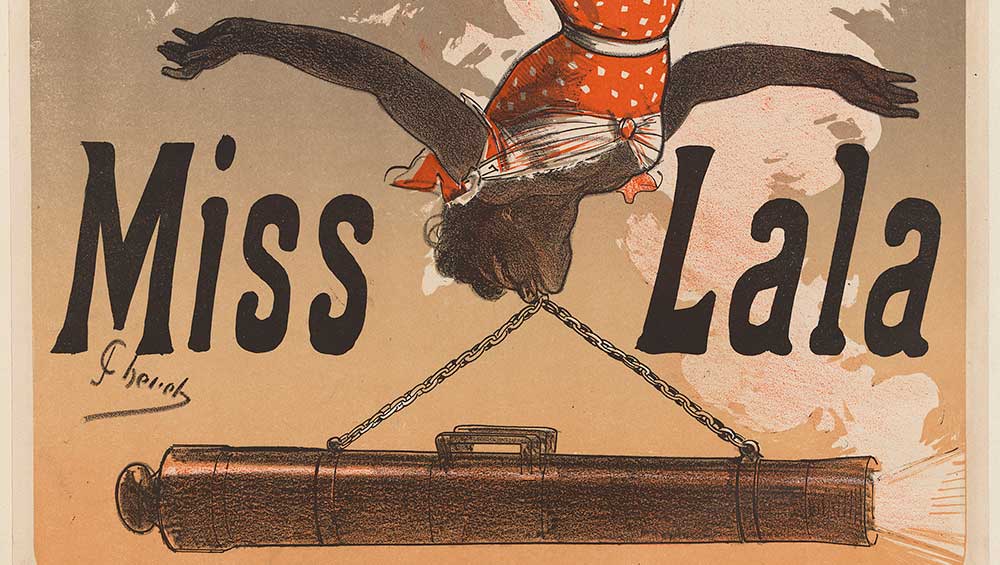
Jules Chéret. Folies-Bergères. Miss Lala, 1880 (detail). Colour lithograph, 55 x 39 cm. Bibliothèque-musée de l'Opéra. © Bibliothèque Nationale de France, Paris.
National Gallery, London
6 June – 1 September 2024
by ANNA McNAY
In among his much-loved pictures of ballet dancers and ladies at their toilette, one painting by the French impressionist Hilaire-Germain-Edgar Degas (1834-1917) in the National Gallery’s collection rather stands out – Miss La La at the Cirque Fernando (1879). At first glance, it is not immediately obvious that the acrobat depicted – the eponymous Miss La La (born Anna Albertine Olga Brown, in 1858, in Pomerania) – is, in fact, suspended by a rope, from the ceiling of the permanent big top, clenching only a leather mouthpiece between her teeth, performing her so-called “iron jaw” stunt. It is a painting that needs some explaining, and so it was the obvious choice for one in the gallery’s series of “Discover” exhibitions, which aim to “explore lesser-known masterpieces in a new light”. In addition, the work came into the national collection early in 1925, and so this is the ideal way to mark its centenary, at the same time as the gallery celebrates its bicentenary.
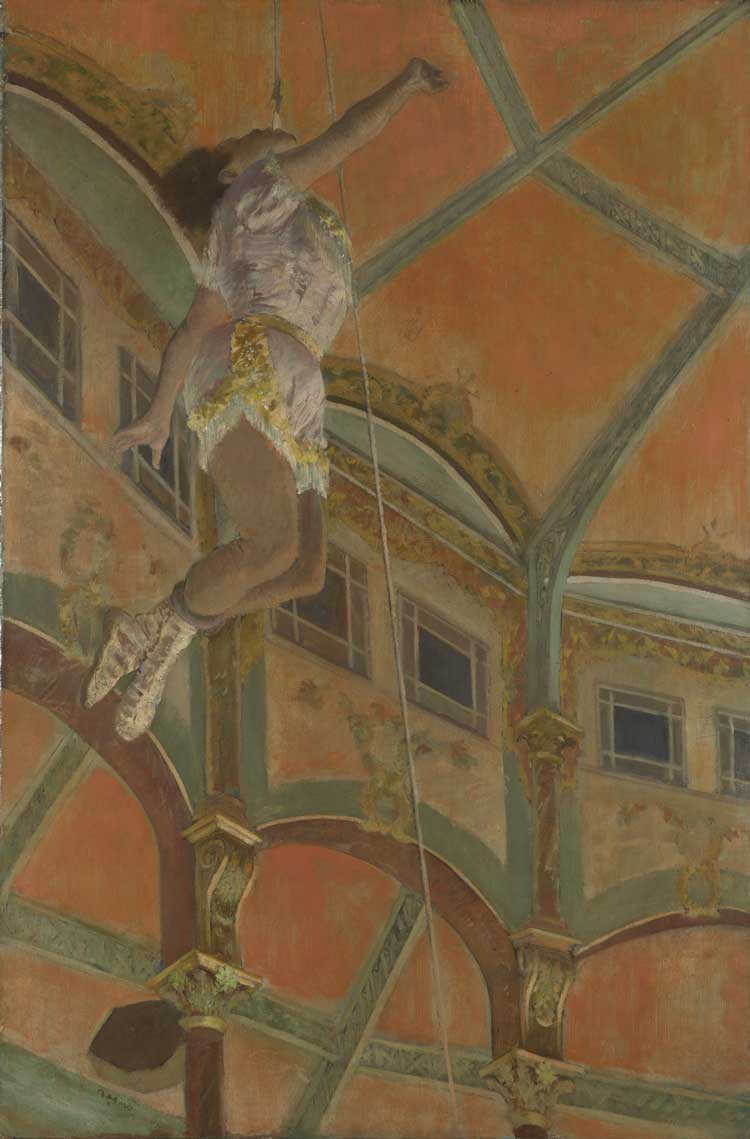
Hilaire-Germain-Edgar Degas. Miss La La at the Cirque Fernando, 1879. Oil on canvas, 117.2 × 77.5 cm. © The National Gallery, London.
The exhibition comprises just 48 works, which are displayed in the Sunley Room in such a way as to conjure the atmosphere of the circus ring, with the focal painting at the centre. Despite its small scale, however, there are many topics to be explored in relation to this one picture. Who was Miss La La? Does she feature in works by other contemporary artists? How did Degas go about making his painting? What has been its story since leaving his hands? And, significant insofar as it has not been addressed before – the Morgan Library in New York held an exhibition of the painting and some of its preparatory sketches in 2013 but left this stone unturned – the question of Miss La La’s ethnicity and how this might tie in with the artist’s own.
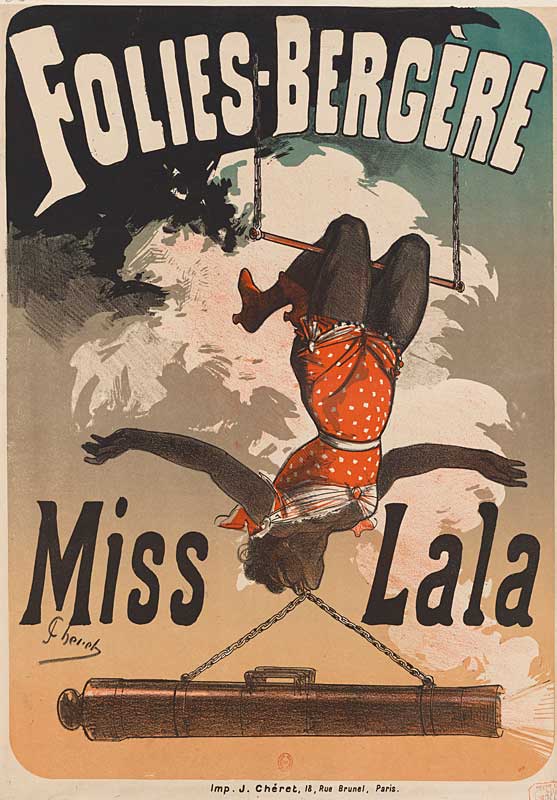
Jules Chéret. Folies-Bergères. Miss Lala, 1880. Colour lithograph, 55 x 39 cm. Bibliothèque-musée de l'Opéra. © Bibliothèque Nationale de France, Paris.
Before entering the main gallery space, visitors arrive in a room full of circus posters, which serve to set the scene of Belle Époque Paris, a burgeoning hub of entertainment in the wake of the Franco-Prussian war. One by Jules Chéret – who is often described as the “father” of poster art, since he developed a new, much more colourful, lithographic technique, and employed the female form and its sexuality as a successful advertising ploy – shows Miss La La at the Folies-Bergère in 1880, performing her second signature stunt: hanging upside down from a trapeze, with a 300kg cannon suspended from her mouth – a cannon that was fired midway through her act.
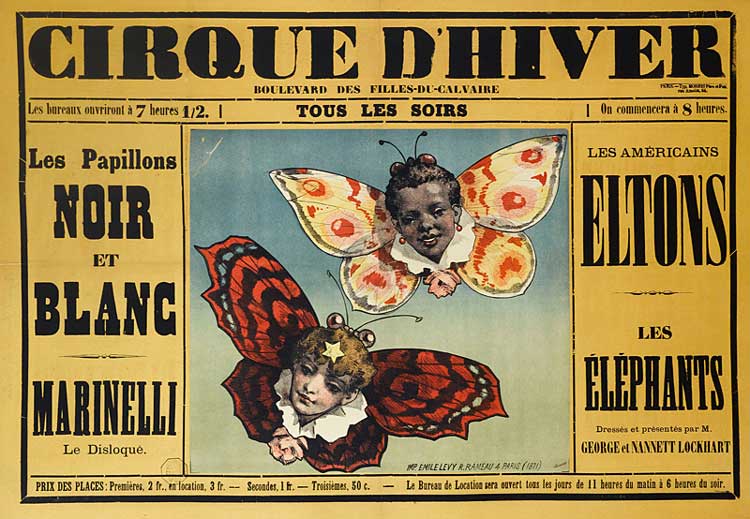
Unknown. Cirque d’hiver, 1884-6. Colour lithograph, 58.9 x 84.5 cm. Musée Carnavalet, Histoire de Paris. © Mairie de Paris, Photothèque des Musées de la ville de Paris.
While Chéret’s Miss La La is visibly dark skinned, other posters make an explicit point of her ethnicity, in a manner clearly problematic today. An advertisement for the Cirque d’Hiver, for example, announces “Les Papillons Noir et Blanc” (“The Black and White Butterflies”), giving rise to racialised and othering representations. It should be noted, however, that Olga went by the stage name of “Miss Albertine the African” until 1877, and she was undoubtedly in control of her own “brand”, having invented her own stunts, performed professionally since the age of 10, and employing an agent. Her heritage was mixed: a white Prussian mother and a Black American father.
Ferdinand Beert, nicknamed Fernando, was the man behind Cirque Fernando, which was located in Montmartre from 1873, initially in a temporary, wood-and-canvas tent, but, from 1875, in a permanent big top. The many artists living and working in the quartier were given free tickets to attend the shows, and, as was Beert’s underlying hope, many of them went on to make pictures advertising his acts, which were, in turn, shown at the annual Paris Salon. Maurice Blum, for example, made the rather kitsch picture, The Circus Performers (1875), which is on show here, depicting a monkey riding a dog and a dog balancing atop a horse.
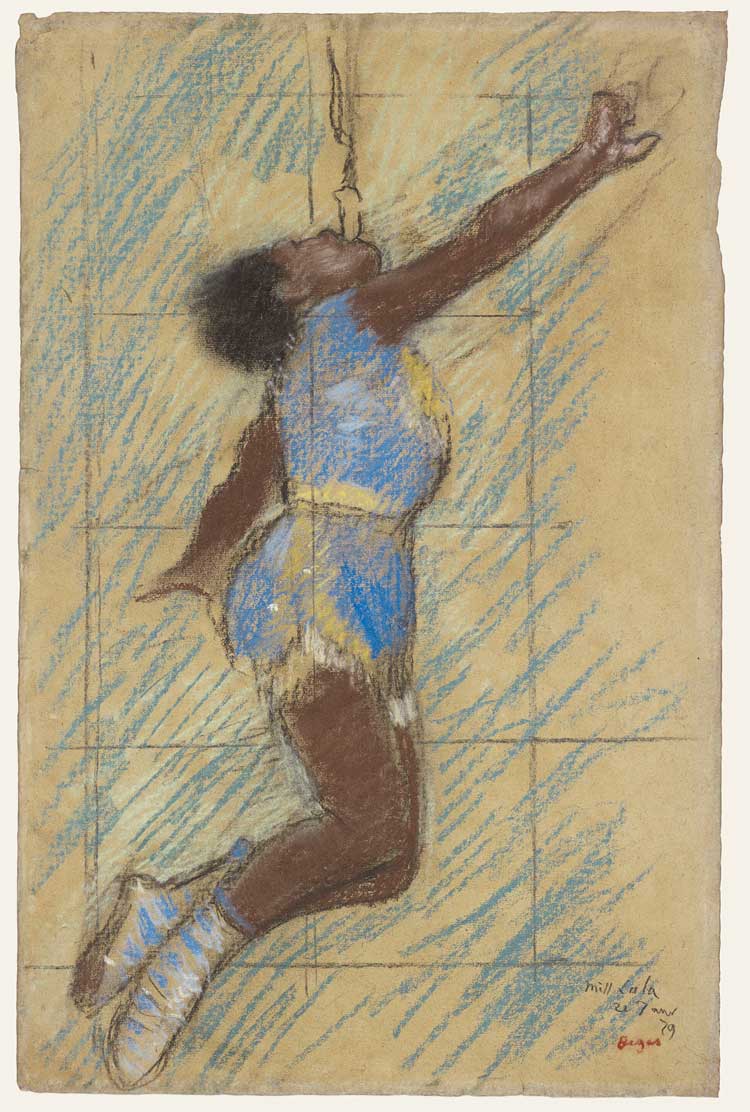
Hilaire-Germain-Edgar Degas. Miss Lala at the Cirque Fernando, 1879. Pastel, 46.4 x 29.8 cm. The J. Paul Getty Museum, Los Angeles, California. Digital image courtesy of the Getty's Open Content Program.
Degas, however, was completely taken with Miss La La – so much so that he invited her to “sit” for him in his studio, and arranged for various props, including a rope, to be on hand, so that she could re-enact her suspended pose. The sessions frequently lasted up to two and a half hours and would have been strenuous for artist and acrobat – and no matter what, Miss La La had to be back at the circus to perform each night from eight o’clock. The sketches and studies that Degas made are endlessly fascinating, showing how he worked on each detail in turn – the tension in the performer’s arms and hands, the crossing of her legs at her ankles, the tilt of her head, the forward thrust of her chest. The exhibition presents sketchbooks and pages, drawn on in pencil, crayon and pastel, some with hints of colour, one with the annotation “bleu vert” (“blue green”) lest he should forget. What Degas struggled with most, however, was the placing of his figure within the circus architecture. We see tentative beams and arches, but in his endeavour to create an upward perspective, as if we, the viewers, were in the audience with Miss La La suspended above us, Degas found himself unable to resolve this background. It is alleged that he resorted to employing a professional architectural draughtsman to help him, and one sketch on display, although attributed to Degas, seems likely to have been one that he commissioned and then went on to use as the basis for his finished painting. One final sketch of the artiste was made months after the completion of the painting, showing just how much of a lasting impact Miss La La had on Degas. This painting is also unique among Degas’s work in having this many preparatory studies associated with it.
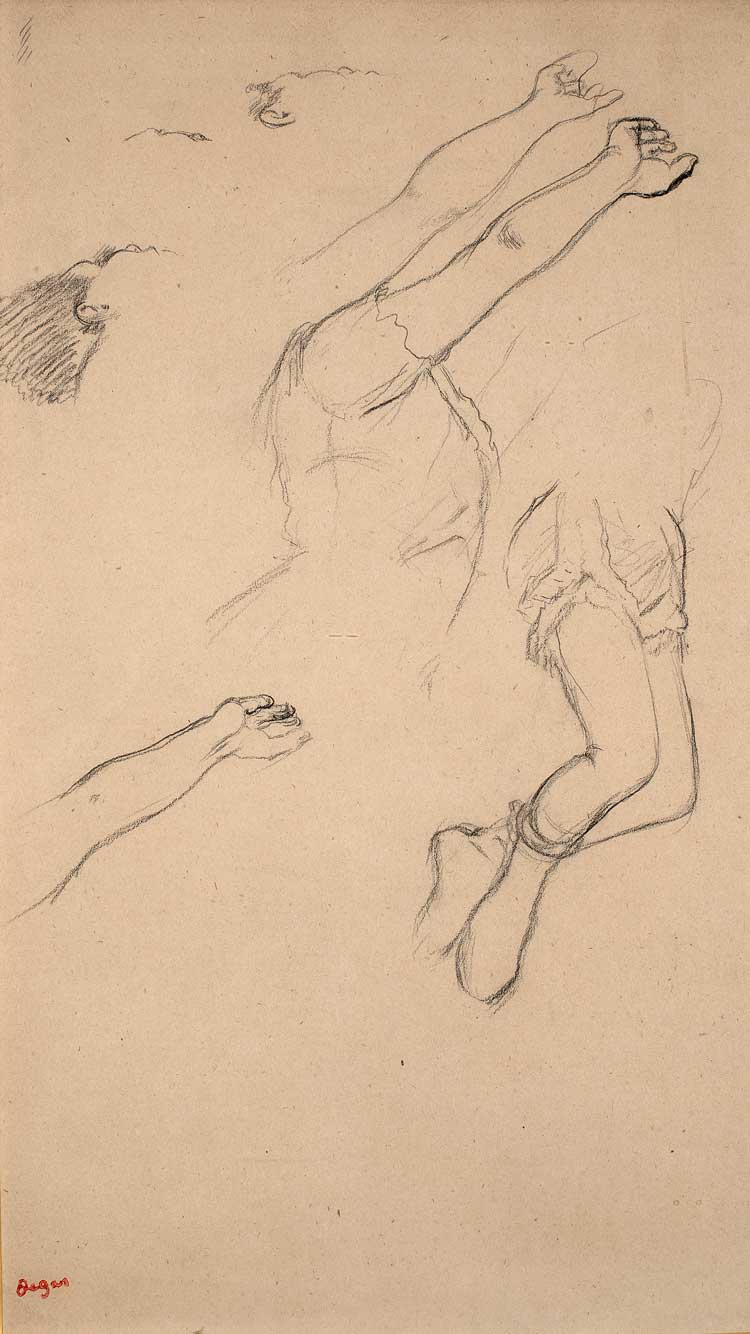
Hilaire-Germain-Edgar Degas. Miss La La au Cirque Fernando, 1879. Charcoal and black pencil on paper, 47.7 x 26.5 cm. Archives Durand-Ruel. © Durand-Ruel & Cie.
At the same time that Degas was working on his picture of Miss La La, he was collaborating with his fellow impressionist artists, Claude Monet, Gustave Caillebotte and Camille Pissarro, to put together the Fourth Impressionist exhibition, which opened on 10 April 1879 in a neo-baroque apartment, newly built as part of Haussmann’s renovation of Paris. The painting of Miss La La was listed in the catalogue, but it was not completed on time and so joined the exhibition only towards the end of its run. This resulted in its receiving very little press and not finding a buyer. It went back to Degas’s studio, where it was to remain for two decades without being shown again. It was not until 1902 that Degas put the picture on consignment to his dealer, Paul Durand-Ruel, and, in 1905, it was shown in the first major exhibition of impressionist art in London, at the Grafton Galleries. Of 315 works on display, only 30 sold, but Miss La La was one of them. A Canadian millionaire took her home with him, but, after he died in 1918 from the Spanish flu, the painting went back on the market and ultimately came before the industrialist Samuel Courtauld, who was building a collection for the British nation. Again, evidencing the peculiar allure Miss La La had on these men, Courtauld also acquired one of the pastel studies for his own, private collection.
Almost as a side note, the exhibition includes a picture by Pierre-Auguste Renoir on loan from the Art Institute of Chicago, painted of the Cirque Fernando in the same year as Degas’, but depicting two young acrobats, Francisca and Angelina Wartenberg. The girls would have been 14 and 17 at the time, but Renoir – who also had private sittings with the girls in his studio – makes them look much younger, and they pose, rather statically, collecting oranges (thrown into the ring by the audience as a sign of appreciation) and preparing to curtsey. Interestingly, however, they wear costumes identical to Miss La La’s. This painting was exhibited in Paris at the same time as the Fourth Impressionist exhibition and was received far more enthusiastically by the crowds.
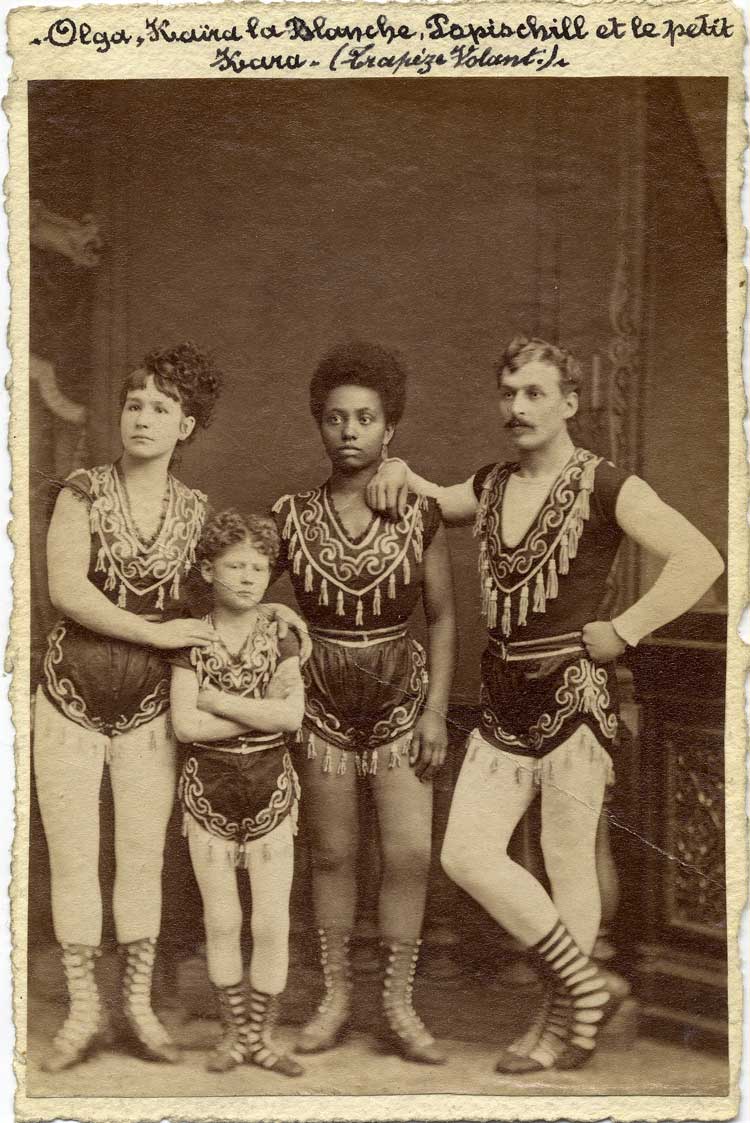
Olga, Kaira la Blanche, Popischill et le petit Kara (Trapèze Volant). Photograph, 13.7 × 8.9 cm. Mucem, Marseille. © Mucem, Marseille.
Through contact made with Olga’s descendants, the curators have been able to include in the display an array of photographs from throughout the acrobat’s life (she retired from the circus at 33, but went on to manage the performing careers of her daughter and nieces and to run a cafe and inn for stage artists in her adopted city of Brussels). Alongside photographs of Olga in costume as Miss La La and Miss Albertine, we see elegant photographic studio portraits, one with her husband (an African American contortionist) and daughter, and a set of six small headshots from when she was in her 80s. It is thrilling to gain this private access into the life and soul of someone who became, as one journalist said at the time, “the attraction of the day”. (The journalist then continued: “To admit that you have not seen her is to lose your reputation as a Parisian.”)
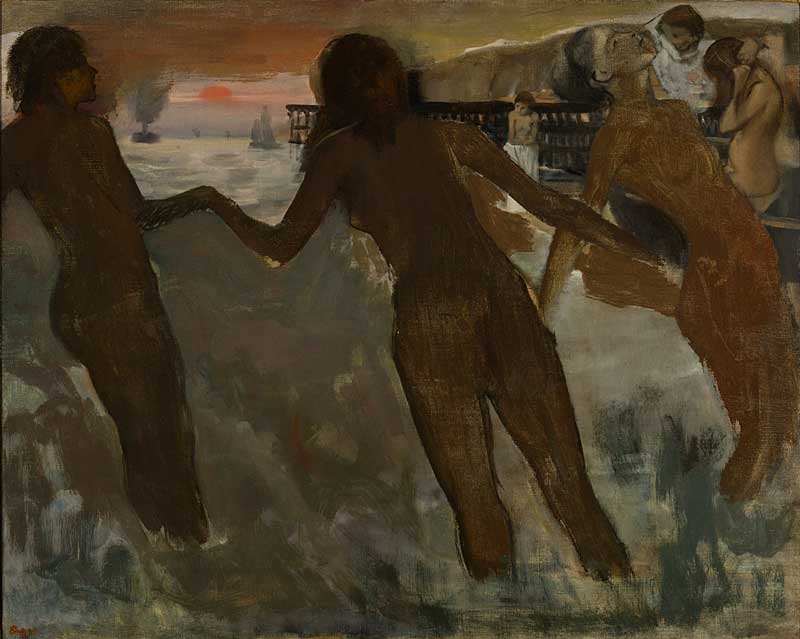
Hilaire-Germain-Edgar Degas. Peasant Girls bathing in the Sea at Dusk, about 1875-6. Oil on canvas, 65 x 81 cm. Private collection. © Photo courtesy of the owner.
Where this exhibition really sets out to make a contribution to art-historical research, however, is in relation to Degas’s depictions of the Black body – and how this ties in with his personal story. The artist’s mother – who died when he was 13 – was a Creole (of European descent) from New Orleans. In 1872 – seven years before his time spent with Miss La La – Degas travelled to Louisiana to spend nearly five months with his maternal uncle and brother, who were working there as cotton merchants (an industry heavily reliant on slave labour). This was Degas’s first encounter with what he termed “the Black world”, and it fascinated him. Courtyard of a House (New Orleans, Sketch) (1873), on loan here from Ordrupgaard in Copenhagen, is a wonderful scene depicting the artist’s nieces and nephews playing on the steps to the house with their nanny. The picture is painted almost as if in sepia, but with bright white flashes on the children’s clothes. The nanny, on the other hand, hidden in her own shadow, is Black. This – and Miss La La – are thought to be the only two paintings Degas made depicting Black figures. That said, he was much affected by the bright Louisiana light, the way it made figures appear as dark silhouettes against a light-flooded backdrop, and the way that this, in turn, impacts our perception of a subject’s skin colour. This was something he would continue to play around with in the years to follow, as exemplified in another painting on display, Peasant Girls Bathing in the Sea at Dusk (1875-76), where the girls are seen from behind, “contre-jour”, or backlit by the setting sun. Lady in Black (1875-78) similarly experiments with this technique, with the shadowy subject seated in front of a luminescent window.
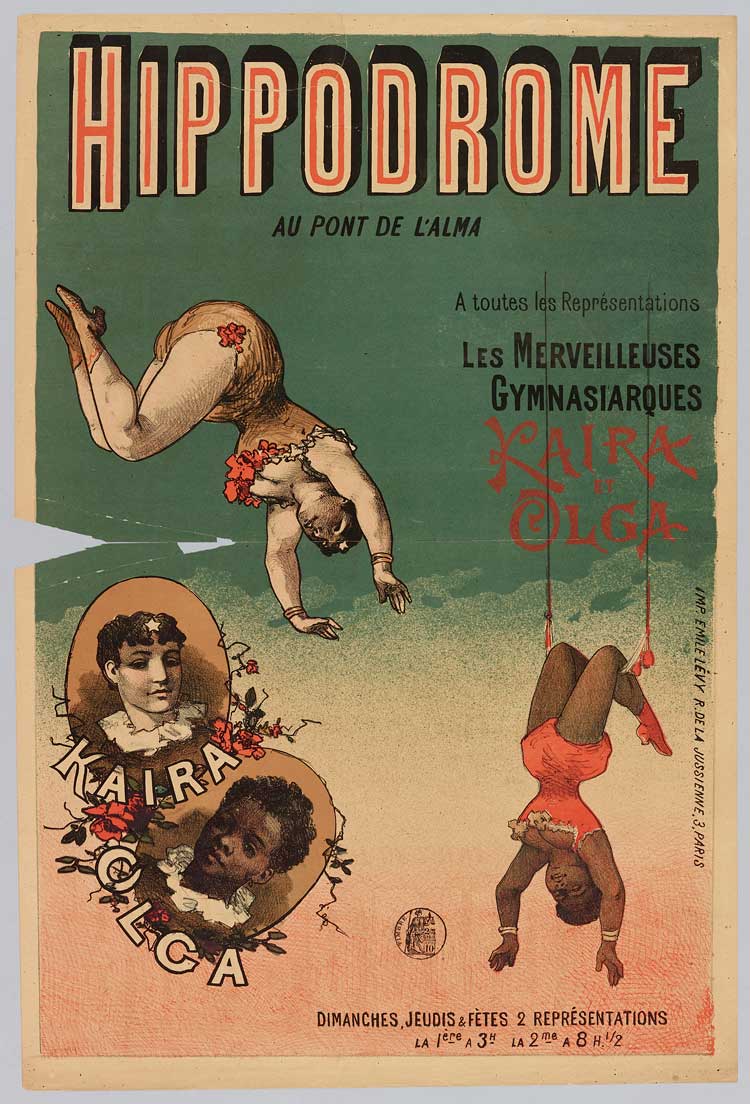
Emile Lévy Imprimeur. Hippodrome au pont de l’Alma, toutes les Représentations Les Merveilleuses Gymnasiarques Kaira et Olga, 1873-83. Colour lithograph, 59.5 x 39.7 cm. Musée Carnavalet, Histoire de Paris. © Mairie de Paris, Photothèque des Musées de la ville de Paris.
It is, therefore, plausible, that Degas, just one year later, might have been especially attracted to the figure of Miss La La because of her skin tone and how this might further his learning and experimentation. Either way, it is remarkable how much can be gleaned, not just about the artist and his sitter, but about social issues as relevant today as nearly 150 years ago, by focusing on just one key work. The National Gallery’s promise that we will “discover” Degas and Miss La La is more than borne out. Congratulations and happy anniversaries!
• The publication to accompany the exhibition Discover Degas and Miss La La was supported by ARTscapades, who also hosted an online talk by the curator Anne Robbins. This review draws from both of these.